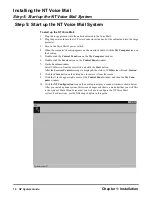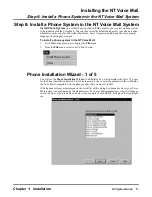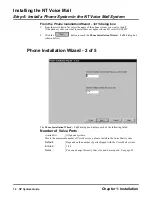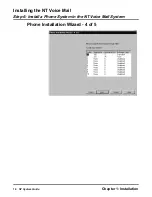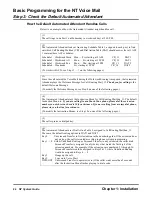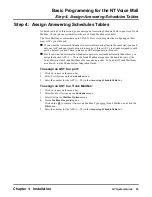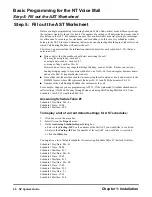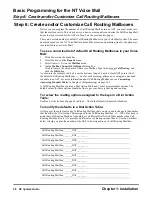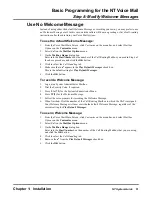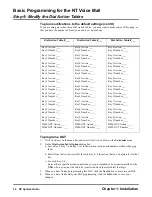
Basic Programming for the NT Voice Mail
Step 3: Check the Default Automated Attendant
Chapter 1: Installation
NT System Guide
23
Step 3: Check the Default Automated Attendant
The Automated Attendant of the Voice Mail answers incoming calls to a mailbox by playing for the
caller any recorded message for that mailbox. A typical mailbox message may begin: Thank you
for calling the ABC company.
Call Routing Mailboxes
To answer calls, the Automated Attendant can use up to 17 different Call Routing Mailboxes
(depending on the configuration of your system). Each Call Routing Mailbox lets callers route their
own calls to an extension, a mailbox, or the Automated Attendant by pressing a dialpad key (0
–
9,
*,#) or several keys on a Touch Tone phone.
The Call Routing Mailbox uses each of the following to help in routing calls:
Q
a Dial Action Table
to assign a routing option (action) to each dialpad key. For example, if you assign the action
“Screened transfer to 306” to key 7, the caller would be able to press Key 7 in order to transfer
to extension 306. Typically, the NT Voice Mail can accommodate up to 500 Dial Action Tables.
Q
a recorded Welcome Message and Instruction Menu
to greet callers and let them them know their call-routing options, which have been programmed
in the Dial Action Table.
Answering Schedule Tables
An AST is a table that you program with the schedules for business and non-business hours at the
company where the Voice Mail system is located. The AST points to a mailbox you have created,
which is typically a Call Routing Mailbox. Using your ASTs helps the Automated Attendant to
answer inbound calls and greet callers differently, depending on the day/date and time when the
call entered the Voice Mail system.
After you assign an AST to a Trunk Mailbox or a port or both, the AST will tell the Automated
Attendant how to route an inbound call to the mailbox containing a timely greeting for the caller. If
you assign the AST to a port, the Voice Mail will use your AST to answer all calls directed to that
port. But if you assign an AST to a Trunk Mailbox and the connected phone system is supplying
incoming trunk I.D. for individual lines, the Voice Mail will use the AST for the Trunk Mailbox to
answer all calls entering on the trunk to which the mailbox is assigned.
However, when an AST is assigned to both a Trunk Mailbox and a port, the AST assignment to the
Trunk Mailbox always takes precedence over the AST assignment to the port: The Voice Mail will
use the AST for the Trunk Mailbox to answer all calls entering on the trunk and ignore the AST
assigned to the port. For more information about using an AST in a Trunk Mailbox, see Trunk Mail-
box on page 299 the Customizing the Mailboxes section in Chapter 3 (Programming).
You can create and program up to 50 ASTs in your Voice Mail system. Each AST may contain up
to 20 schedules for delivering greetings to outside callers. After a call reaches the mailbox pointed
to by an AST schedule, the caller will hear the greeting recorded for that mailbox. For more infor-
mation about using an AST in a Trunk Mailbox, see the flowchart in the Customizing Answering
Schedule Tables on page 105 in Chapter 3 (Programming).
Default Settings for Call Routing Mailboxes
To display default settings for your Call Routing Mailboxes:
1.
Click Reports on the menu bar of the Voice Mail Main Screen.
2.
Select Mailbox on the Reports menu.
3.
Select Numeric List on the Mailbox menu.
4.
On the Mailbox Numeric List Report dialog box:
Click on the
to remove it from every Mailbox Type except Call Routing Mailbox, and click
the OK button.
Summary of Contents for NVM-NT
Page 28: ...Table of Contents Chapter 5 Maintenance xxvi NT System Guide ...
Page 130: ...Installing SMDI 102 NT System Guide Chapter 3 Programming ...
Page 146: ...Customizing Caller I D Tables General Tab 118 NT System Guide Chapter 3 Programming ...
Page 156: ...Customizing Callout Options Optional Tab 128 NT System Guide Chapter 3 Programming ...
Page 182: ...Customizing Distribution Lists General Tab 154 NT System Guide Chapter 3 Programming ...
Page 338: ...Customizing Port Options General Tab 310 NT System Guide Chapter 3 Programming ...
Page 358: ...Customizing System Options Timers Tab 330 NT System Guide Chapter 3 Programming ...
Page 362: ...Customizing System Options Timers Tab 334 NT System Guide Chapter 3 Programming ...
Page 367: ...Customizing Tenant Options General Tab Chapter 3 Programming NT System Guide 339 ...
Page 396: ...Viewing and Printing Reports System Options Report 368 NT System Guide Chapter 3 Programming ...
Page 400: ...Performing a Local Backup Backup Dialog Box 372 NT System Guide Chapter 3 Programming ...
Page 440: ...Using Port Activities 412 NT System Guide Chapter 3 Programming ...
Page 454: ...Using Message Status Message Status Dialog Box 426 NT System Guide Chapter 3 Programming ...


